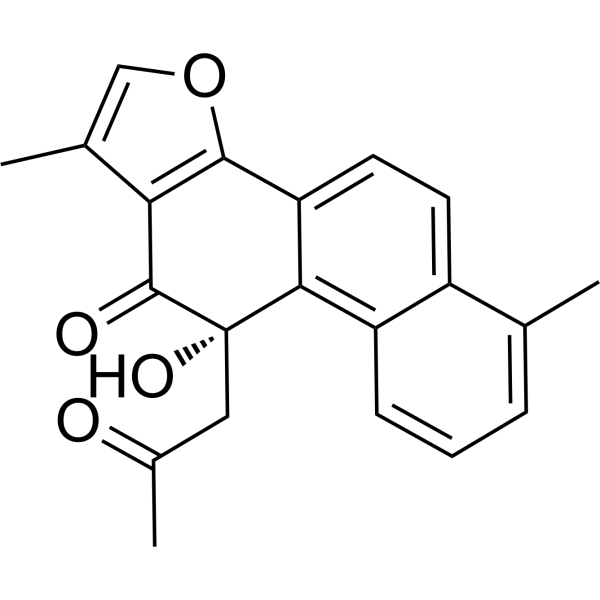Dehydrodanshenol ACAS# 1444618-61-4 |

Quality Control & MSDS
Package In Stock
Number of papers citing our products

| Cas No. | 1444618-61-4 | SDF | Download SDF |
| PubChem ID | N/A | Appearance | Powder |
| Formula | C21H18O4 | M.Wt | 334.37 |
| Type of Compound | Diterpenoids | Storage | Desiccate at -20°C |
| Synonyms | (10S)-10-Hydroxy-1,6-dimethyl-10-(2-oxopropyl)naphtho[1,2-g][1]benzofuran-11-one | ||
| Solubility | Soluble in Chloroform,Dichloromethane,Ethyl Acetate,DMSO,Acetone,etc. | ||
| General tips | For obtaining a higher solubility , please warm the tube at 37 ℃ and shake it in the ultrasonic bath for a while.Stock solution can be stored below -20℃ for several months. We recommend that you prepare and use the solution on the same day. However, if the test schedule requires, the stock solutions can be prepared in advance, and the stock solution must be sealed and stored below -20℃. In general, the stock solution can be kept for several months. Before use, we recommend that you leave the vial at room temperature for at least an hour before opening it. |
||
| About Packaging | 1. The packaging of the product may be reversed during transportation, cause the high purity compounds to adhere to the neck or cap of the vial.Take the vail out of its packaging and shake gently until the compounds fall to the bottom of the vial. 2. For liquid products, please centrifuge at 500xg to gather the liquid to the bottom of the vial. 3. Try to avoid loss or contamination during the experiment. |
||
| Shipping Condition | Packaging according to customer requirements(5mg, 10mg, 20mg and more). Ship via FedEx, DHL, UPS, EMS or other couriers with RT, or blue ice upon request. | ||

Dehydrodanshenol A Dilution Calculator

Dehydrodanshenol A Molarity Calculator
| 1 mg | 5 mg | 10 mg | 20 mg | 25 mg | |
| 1 mM | 2.9907 mL | 14.9535 mL | 29.907 mL | 59.814 mL | 74.7675 mL |
| 5 mM | 0.5981 mL | 2.9907 mL | 5.9814 mL | 11.9628 mL | 14.9535 mL |
| 10 mM | 0.2991 mL | 1.4953 mL | 2.9907 mL | 5.9814 mL | 7.4767 mL |
| 50 mM | 0.0598 mL | 0.2991 mL | 0.5981 mL | 1.1963 mL | 1.4953 mL |
| 100 mM | 0.0299 mL | 0.1495 mL | 0.2991 mL | 0.5981 mL | 0.7477 mL |
| * Note: If you are in the process of experiment, it's necessary to make the dilution ratios of the samples. The dilution data above is only for reference. Normally, it's can get a better solubility within lower of Concentrations. | |||||

Calcutta University

University of Minnesota

University of Maryland School of Medicine

University of Illinois at Chicago

The Ohio State University

University of Zurich

Harvard University

Colorado State University

Auburn University

Yale University

Worcester Polytechnic Institute

Washington State University

Stanford University

University of Leipzig

Universidade da Beira Interior

The Institute of Cancer Research

Heidelberg University

University of Amsterdam

University of Auckland

TsingHua University

The University of Michigan

Miami University

DRURY University

Jilin University

Fudan University

Wuhan University

Sun Yat-sen University

Universite de Paris

Deemed University

Auckland University

The University of Tokyo

Korea University
- Hymenoxin
Catalog No.:BCX1882
CAS No.:56003-01-1
- Pebrellin
Catalog No.:BCX1881
CAS No.:13509-93-8
- Chrysindin A
Catalog No.:BCX1880
CAS No.:1374852-85-3
- 3-Epidigitoxigenin
Catalog No.:BCX1879
CAS No.:545-52-8
- Marsdenoside B
Catalog No.:BCX1878
CAS No.:858360-57-3
- 11α-O-Tigloyl-12β-O-acetyltenacigenin B
Catalog No.:BCX1877
CAS No.:154022-51-2
- Ingol-7,8,12-triacetate-3-phenylacetate
Catalog No.:BCX1876
CAS No.:944799-46-6
- Euphorblin R
Catalog No.:BCX1875
CAS No.:2230806-06-9
- Strictinin
Catalog No.:BCX1874
CAS No.:517-46-4
- Tenuiphenone B
Catalog No.:BCX1873
CAS No.:870298-00-3
- Glomeratide A
Catalog No.:BCX1872
CAS No.:1072028-74-0
- Machilin A
Catalog No.:BCX1871
CAS No.:110269-50-6
- 2,4,6-Trimethoxyl-3-methylacetophenone
Catalog No.:BCX1884
CAS No.:39701-13-8
- Sibiriquinone A
Catalog No.:BCX1885
CAS No.:723300-08-1
- 3-Epigitoxigenin
Catalog No.:BCX1886
CAS No.:465-10-1
- Lasiokaurinin
Catalog No.:BCX1887
CAS No.:52554-74-2
- Dichlorogelignate
Catalog No.:BCX1888
CAS No.:164030-91-5
- Digoxigenin
Catalog No.:BCX1889
CAS No.:1672-46-4
- 17α-Gitoxigenin
Catalog No.:BCX1890
CAS No.:4433-59-4
- Digitalin, 16-anhydro-
Catalog No.:BCX1891
CAS No.:7044-34-0
- Abrine D
Catalog No.:BCX1896
CAS No.:862504-05-0
- 4-((2-ethylidene-4-hydroxy-6-methylhept-5-en-1-yl)oxy)-bergaptol
Catalog No.:BCX1892
CAS No.:2519548-06-0
- 3,5,6,6-tetramethyl-4,5,5a,6,7,8-hexahydrocyclopenta[c]pentalen-2(1H)-one
Catalog No.:BCX1893
CAS No.:1689570-10-2
- Genistein 7-O-β-D-glucopyranoside-4’-O-[α-L-rhamnopyranosyl-(1→2)-β-D-glucopyranoside]
Catalog No.:BCX2014
CAS No.:361447-29-2
Characterization of the inhibitory activity of natural tanshinones from Salvia miltiorrhiza roots on protein tyrosine phosphatase 1B.[Pubmed:29031618]
Chem Biol Interact. 2017 Dec 25;278:65-73.
Protein tyrosine phosphatase 1B (PTP1B) is a negative regulator that plays an important role in many signaling pathways, especially those associated with insulin resistance. In this study, we investigated the anti-diabetic potential of 12 natural tanshinones isolated from Salvia miltiorrhiza (S. miltiorrhiza) Bunge (Lamiaceae), deoxyneocryptotanshinone (1), grandifolia F (2), ferruginol (3), cryptotanshinone (4), tanshinone IIA (5), tanshinol B (6), tanshinone IIB (7), tanshinonal (8), methyl tanshinonate (9), 15,16-dihydrotanshinone I (10), tanshinone I (11), and Dehydrodanshenol A (12) and evaluated their inhibitory activity against PTP1B. Tanshinones 4, 6 and 12 exhibited potent PTP1B inhibitory activity with IC(50) values of 5.5 +/- 0.9, 4.7 +/- 0.4 and 8.5 +/- 0.5 muM, respectively. In addition, tanshinones 1-3, 5 and 7-11 showed promising dose-dependent inhibition of PTP1B over IC(50) values ranging from 18.6 to 254.8 muM. Enzyme kinetic analysis of PTP1B inhibition revealed that 4 and 6 were mixed -noncompetitive type inhibitors, whereas 12 was a classical-noncompetitive type inhibitor. Furthermore, 4, 6 and 12 were docked with the PTP1B enzyme using molecular docking simulations (AutoDock 4.2) and exhibited negative binding energy (-6.4 to -8.7 kcal/mol), indicating high binding affinity to PTP1B active site residues. Structure-activity relationships (SAR) analysis revealed that structural modifications of ring A and furan or dihydrofuran ring D on the basic structure of tanshinones influenced their activity. Overall, results indicated that tanshinones from S. miltiorrhiza are potential anti-diabetic candidates that should be explored in the development of preventive and therapeutic modalities for the treatment of diabetes as well as diabetes-associated complications.


